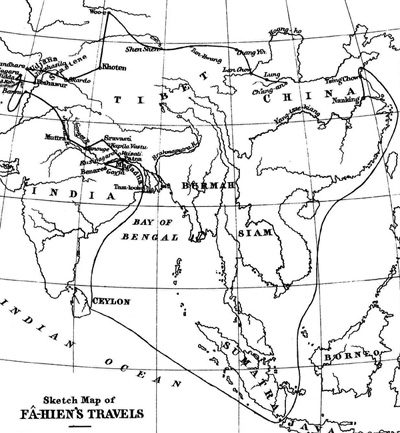In AD 414, he recorded his travels in "Record of Buddhist Countries" today known as the "Travels of Fa-Hsien". It is an excellent geographic account of his journey along the Silk Roads, and an comprehensive report of the history and customs of Central Asia and India.
 Fa-hsien, while traveling
through the dangerous Taklamakan desert left us with this account:
Fa-hsien, while traveling
through the dangerous Taklamakan desert left us with this account:
"...We journeyed on and reached Tun-huang (Dunhuang) at the end of the Great Wall, where the frontier is held by the military for a distance of eighty le from east to west, and forty le from north to south (one li---is one-third of a mile). Having stayed there for more than a month, the governor of Tun-huang provided us with all the necessary provisions for crossing the desert. We than traveled on with an envoy of a camel train...In this desert there are great many evil spirits and hot winds; those who encounter them perish to a man. There are neither birds above nor beasts below. Gazing on all sides as far as the eye can reach in order to mark the track, no guidance is to be obtained save from the rotting bones of dead men, which point the way."
After traveling for seventeen days, about 1,500 le, they arrived at the country of Shan-shan, today's Lop-Nor, which was a thriving oasis at that time. Fa-hsien reports:
"This land is rugged and barren...The king of this country has received the Faith, and there are some four thousand and more priests, all belonging to the Lesser Vehicle, but all practice the religion of India".
He also left a vivid account of the Kingdom of Khotan, on the southern arm of the Silk Road, where he stayed for three months. He reports that there were fourteen large monasteries, 'without counting the smaller ones'. He continued on his pilgrimage via the Kingdom of Kashgar, where the northern and southern branches of the Silk Roads reunite. He also tells us that he observed the Buddhist practice of resting during the summer and rainy seasons, and the differences between the Chinese and Indian calendars. Traveling through Afghanistan (Punjab), he commands: "...there are approximately three thousand priests belonging to both the Greater and Lesser Vehicles. Here we kept out summer retreat, and when it was over, we proceeded southwards..." In India he reports of the Middle Kingdom as. "It has a temperate climate, without frost or snow, and the people are all happy". There he spend six years in one of the most prosperous periods of the Gupta dynasty.
The purpose of his travels to India was to collect Buddhist canon to bring back to China, and it took him three more years returning to China AD 413. He traveled through nearly thirty countries from China's most treacherous deserts to the land of India. He recorded his extensive and hazardous travels on bamboo and silk, for the benefit of future explorers and historians.